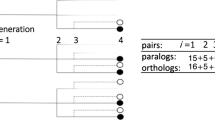Abstract
We study modeling and inference problems around the process of fractionation, or the genome-wide process of losing one gene per duplicate pair following whole genome doubling (WGD), motivated by the evolution of plants over many tens of millions of years, with their repeated cycles of genome doubling and fractionation. We focus on the frequency distribution of similarities between the two genes, over all the duplicate pairs in the genome. Our model is fully general, accounting for repeated duplication, triplication or other k-tupling events (all subsumed under the term WGD), as well as a general fractionation rate in any time period among multiple progeny of a single gene. It also has a biologically and combinatorially well-motivated way of handling the tendency for at least one sibling to survive fractionation. We show how the method reduces to previously proposed models for special cases, and settles unresolved questions about the expected number of gene pairs tracing their ancestry back to each WGD event.
Access this chapter
Tax calculation will be finalised at checkout
Purchases are for personal use only
Similar content being viewed by others
References
Eckardt, N.: A sense of self: the role of DNA sequence elimination in allopolyploidization. Plant Cell 13, 1699–1704 (2001)
Freeling, M., Woodhouse, M.R., Subramaniam, S., Turco, G., Lisch, D., Schnable, J.C.: Fractionation mutagenesis and similar consequences of mechanisms removing dispensable or less-expressed DNA in plants. Curr. Opin. Plant Biol. 15(2), 131–139 (2012)
McLachlan, G.J., Peel, D., Basford, K.E., Adams, P.: The EMMIX software for the fitting of mixtures of normal and t-components. J. Stat. Softw. 4(2), 1–14 (1999)
Zhang, Y., Zheng, C., Sankoff, D.: Evolutionary model for the statistical divergence of paralogous and orthologous gene pairs generated by whole genome duplication and speciation. IEEE/ACM Trans. Comput. Biol. Bioinform. (2017). doi:10.1109/TCBB.2017.2712695
Sankoff, D., Zheng, C., Zhang, Y., Meidanis, J., Lyons, E., Tang, H.: Models for similarity distributions of syntenic homologs and applications to phylogenomics. IEEE/ACM Trans. Comput. Biol. Bioinform. (2017, in press)
Nadeau, J.H., Sankoff, D.: Comparable rates of gene loss and functional divergence after genome duplications early in vertebrate evolution. Genetics 147(3), 1259–1266 (1997)
Kumar, S., Subramanian, S.: Mutation rates in mammalian genomes. Proc. Nat. Acad. Sci. 99(2), 803–808 (2002)
Lyons, E., Freeling, M.: How to usefully compare homologous plant genes and chromosomes as DNA sequences. Plant J. 53(4), 661–673 (2008). doi:10.1111/j.1365-313X.2007.03326.x
Lyons, E., Pedersen, B., Kane, J., Alam, M., Ming, R., Tang, H., Wang, X., Bowers, J., Paterson, A., Lisch, D., Freeling, M.: Finding and comparing syntenic regions among Arabidopsis and the outgroups papaya, poplar and grape: CoGe with rosids. Plant Physiol. 148, 1772–1781 (2008)
Murat, F., Armero, A., Pont, C., Klopp, C., Salse, J.: Reconstructing the genome of the most recent common ancestor of flowering plants. Nat. Genet. 49(4), 490–496 (2017)
Tomato Genome Consortium: The tomato genome sequence provides insights into fleshy fruit evolution. Nature 485, 635–641 (2012)
Hirakawa, H., Shirasawa, K., Kosugi, S., Tashiro, K., Nakayama, S., Yamada, M., Kohara, M., Watanabe, A., Kishida, Y., Fujishiro, T., et al.: Dissection of the octoploid strawberry genome by deep sequencing of the genomes of Fragaria species. DNA Res. 21(2), 169–181 (2014)
Acknowledgements
Research supported in part by grants from the Natural Sciences and Engineering Research Council of Canada. DS holds the Canada Research Chair in Mathematical Genomics.
Author information
Authors and Affiliations
Corresponding author
Editor information
Editors and Affiliations
Rights and permissions
Copyright information
© 2017 Springer International Publishing AG
About this paper
Cite this paper
Zhang, Y., Sankoff, D. (2017). The Similarity Distribution of Paralogous Gene Pairs Created by Recurrent Alternation of Polyploidization and Fractionation. In: Meidanis, J., Nakhleh, L. (eds) Comparative Genomics. RECOMB-CG 2017. Lecture Notes in Computer Science(), vol 10562. Springer, Cham. https://doi.org/10.1007/978-3-319-67979-2_1
Download citation
DOI: https://doi.org/10.1007/978-3-319-67979-2_1
Published:
Publisher Name: Springer, Cham
Print ISBN: 978-3-319-67978-5
Online ISBN: 978-3-319-67979-2
eBook Packages: Computer ScienceComputer Science (R0)




